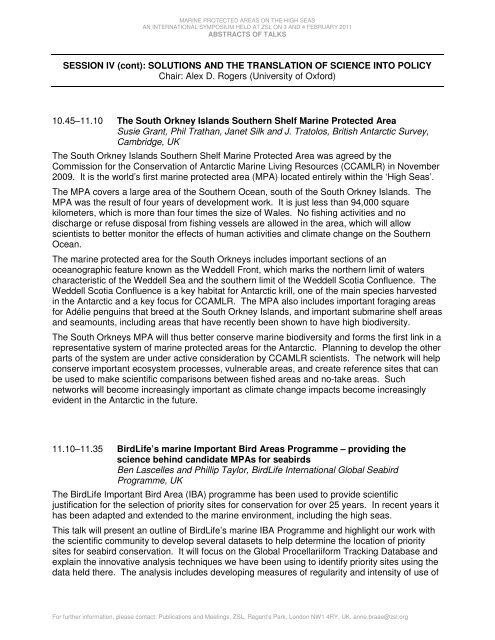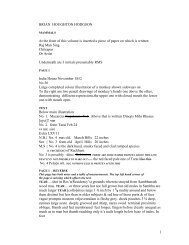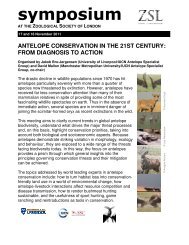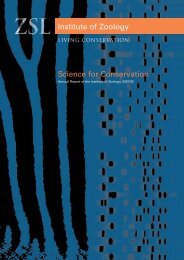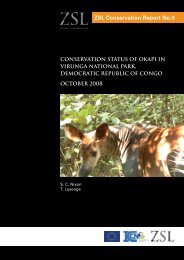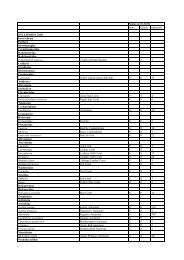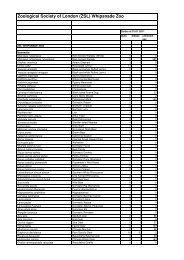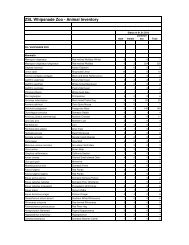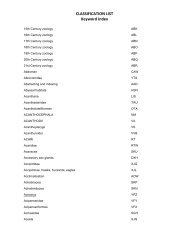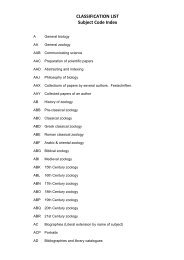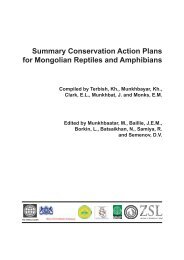MPA Symposium - Zoological Society of London
MPA Symposium - Zoological Society of London
MPA Symposium - Zoological Society of London
Create successful ePaper yourself
Turn your PDF publications into a flip-book with our unique Google optimized e-Paper software.
MARINE PROTECTED AREAS ON THE HIGH SEAS<br />
AN INTERNATIONAL SYMPOSIUM HELD AT ZSL ON 3 AND 4 FEBRUARY 2011<br />
ABSTRACTS OF TALKS<br />
SESSION IV (cont): SOLUTIONS AND THE TRANSLATION OF SCIENCE INTO POLICY<br />
Chair: Alex D. Rogers (University <strong>of</strong> Oxford)<br />
10.45–11.10 The South Orkney Islands Southern Shelf Marine Protected Area<br />
Susie Grant, Phil Trathan, Janet Silk and J. Tratolos, British Antarctic Survey,<br />
Cambridge, UK<br />
The South Orkney Islands Southern Shelf Marine Protected Area was agreed by the<br />
Commission for the Conservation <strong>of</strong> Antarctic Marine Living Resources (CCAMLR) in November<br />
2009. It is the world’s first marine protected area (<strong>MPA</strong>) located entirely within the ‘High Seas’.<br />
The <strong>MPA</strong> covers a large area <strong>of</strong> the Southern Ocean, south <strong>of</strong> the South Orkney Islands. The<br />
<strong>MPA</strong> was the result <strong>of</strong> four years <strong>of</strong> development work. It is just less than 94,000 square<br />
kilometers, which is more than four times the size <strong>of</strong> Wales. No fishing activities and no<br />
discharge or refuse disposal from fishing vessels are allowed in the area, which will allow<br />
scientists to better monitor the effects <strong>of</strong> human activities and climate change on the Southern<br />
Ocean.<br />
The marine protected area for the South Orkneys includes important sections <strong>of</strong> an<br />
oceanographic feature known as the Weddell Front, which marks the northern limit <strong>of</strong> waters<br />
characteristic <strong>of</strong> the Weddell Sea and the southern limit <strong>of</strong> the Weddell Scotia Confluence. The<br />
Weddell Scotia Confluence is a key habitat for Antarctic krill, one <strong>of</strong> the main species harvested<br />
in the Antarctic and a key focus for CCAMLR. The <strong>MPA</strong> also includes important foraging areas<br />
for Adélie penguins that breed at the South Orkney Islands, and important submarine shelf areas<br />
and seamounts, including areas that have recently been shown to have high biodiversity.<br />
The South Orkneys <strong>MPA</strong> will thus better conserve marine biodiversity and forms the first link in a<br />
representative system <strong>of</strong> marine protected areas for the Antarctic. Planning to develop the other<br />
parts <strong>of</strong> the system are under active consideration by CCAMLR scientists. The network will help<br />
conserve important ecosystem processes, vulnerable areas, and create reference sites that can<br />
be used to make scientific comparisons between fished areas and no-take areas. Such<br />
networks will become increasingly important as climate change impacts become increasingly<br />
evident in the Antarctic in the future.<br />
11.10–11.35 BirdLife’s marine Important Bird Areas Programme – providing the<br />
science behind candidate <strong>MPA</strong>s for seabirds<br />
Ben Lascelles and Phillip Taylor, BirdLife International Global Seabird<br />
Programme, UK<br />
The BirdLife Important Bird Area (IBA) programme has been used to provide scientific<br />
justification for the selection <strong>of</strong> priority sites for conservation for over 25 years. In recent years it<br />
has been adapted and extended to the marine environment, including the high seas.<br />
This talk will present an outline <strong>of</strong> BirdLife’s marine IBA Programme and highlight our work with<br />
the scientific community to develop several datasets to help determine the location <strong>of</strong> priority<br />
sites for seabird conservation. It will focus on the Global Procellariiform Tracking Database and<br />
explain the innovative analysis techniques we have been using to identify priority sites using the<br />
data held there. The analysis includes developing measures <strong>of</strong> regularity and intensity <strong>of</strong> use <strong>of</strong><br />
For further information, please contact: Publications and Meetings, ZSL, Regent’s Park, <strong>London</strong> NW1 4RY, UK. anne.braae@zsl.org


